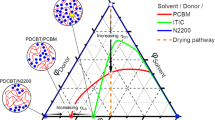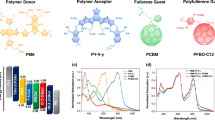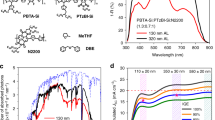Abstract
The most efficient plastic solar cells comprise a blend of conjugated polymer and a suitable electron acceptor, typically a fullerene derivative. Therefore narrow-bandgap conjugated polymers are currently sought for the fabrication of such devices. A significant challenge is being able to predict device function and performance from consideration of the molecular connectivity and dimensions of the partners within the active layer. Improved chemical syntheses are therefore required to make structurally varied polymers and enable the delineation of structure–function relationships with the aim of improving power conversion efficiencies. Here, we demonstrate that microwave heating in combination with the screening of comonomer reactant ratios can be used to obtain donor–acceptor copolymers with high average molecular weights and properties that make them suitable for solar cell incorporation. Furthermore, we highlight the importance of high molecular weight and the contribution of solubilizing side groups in determining the final device properties.
This is a preview of subscription content, access via your institution
Access options
Subscribe to this journal
Receive 12 print issues and online access
$259.00 per year
only $21.58 per issue
Buy this article
- Purchase on Springer Link
- Instant access to full article PDF
Prices may be subject to local taxes which are calculated during checkout





Similar content being viewed by others
References
Gilles, D., Scharber, M. C. & Brabec, C. J. Polymer-fullerene bulk-heterojunction solar cells. Adv. Mater. 21, 1323–1338 (2009).
Peet, J., Heeger, A. J. & Bazan, G. C. Plastic solar cells: self-assembly by bulk heterojunction nanomaterials by spontaneous phase separation. Acc. Chem. Res. doi: 10.1021/ar900065j, (2009).
Krebs, F. C. Fabrication and processing of polymer solar cells: A review of printing and coating techniques. Sol. Energy Mater. Sol. C. 93, 394–412 (2009).
Kippelen, B. & Bredas, J. L. Organic photovoltaics. Ener. Env. Sci. 2, 251–261 (2009).
Blom, P. W. M., Mihailetchi, V. D., Koster, L. A. J. & Markov, D. E. Device physics of polymer:fullerene bulk heterojunction solar cells. Adv. Mater. 19, 1551–1566 (2007).
Kroon, R., Lenes, M., Hummelen, J. C., Blom, P. W. M. & de Boer, B. Small bandgap polymers for organic solar cells (polymer material development in the last five years). Polymer Rev. 48, 531–582 (2008).
Scharber M. C. et al. Design rules for donors in bulk heterojunction solar cells – towards 10% energy conversion efficiency. Adv. Mater. 18, 789–794 (2006).
Park, S. H. et al. Bulk heterojunction solar cells with internal quantul efficiency approaching 100%. Nature Photon. 3, 297–302 (2009).
Liang, Y. et al. Development of new semi-conducting polymers for high performance solar cells. J. Am. Chem. Soc. 131, 56–57 (2009).
Liang, Y. et al. Highly efficient solar cell polymers developed via fine-tuning of structural and electronic properties. J. Am. Chem. Soc. 131, 7792–7799 (2009).
Peet, J. et al. Efficiency enhancement in low-bandgap polymer solar cells by processing with alkane dithiols. Nature Mater. 6, 497–500 (2007).
Lee, J. K. et al. Processing additives for improved efficiency from bulk heterojunction solar cells. J. Am. Chem. Soc. 130, 3619–3623 (2008).
Yang, X. & Loos, J. Towards high-performance polymer solar cells: the importance of morphology control. Macromolecules 40, 1353–1362 (2007).
Kim et al. A strong regioregularity effect in self-organizing conjugated polymer films and high-efficiency polythiophene:fullerene solar cells. Nature Mater. 5, 197–203 (2006).
Chen, M.-H. et al. Efficient polymer solar cells with thin active layers based on alternating polyfluorene copolymer/fullerene bulk heterojunctions. Adv. Mater. 21, 1–5 (2009).
Zhu, Z. et al. Panchromatic conjugated polymers containing alternating donor/acceptor units for photovoltaic applications. Macromolecules 40, 1981–1986 (2007).
Hou, J., Chen, H.-Y., Zhang, S., Li, G. & Yang, Y. Synthesis, characterization, and photovoltaic properties of a low band gap polymer based on silole-containing polythiophenes and 2,1,3-benzothiadiazole. J. Am. Chem. Soc. 130, 16144–16145 (2008).
Muhlbacher, D. et al. High photovoltaic performance of a low-bandgap polymer. Adv. Mater. 18, 2884–2889 (2006).
Tierney, S., Heeney, M. & McCulloch, I. Microwave-assisted synthesis od polythiophene via the Stille coupling. Synth. Met. 148, 195–198 (2005).
McCulloch, I. et al. Liquid-crystalline semiconducting polymers with high charge-carrier mobility. Nature Mater. 5, 328–333 (2006).
Chen, J. & Cao, Y. Silole-containing polymers: chemistry and optoelectronic properties. Macromol. Rapid Commun. 28, 1714–1742 (2007).
Brzezinski, J. Z. & Reynolds, J. R. A new, improved and convenient synthesis of 4H-cyclopenta[2,1-b:3,4-b′]-dithiophen-4-one. Synthesis 1053–1056 (2002).
Coppo, P., Cupertino, D. C., Yeates, S. G. & Turner, M. L. Synthetic routes to solution- processable polycyclopentadithiophenes. Macromolecules 36, 2705–2711 (2003).
Usta, H., Lu, G., Facchetti, A. & Marks, T. J. Dithienosilole– and dibenzosilole–thiophene copolymers as semiconductors for organic thin-film transistors. J. Am. Chem. Soc. 128, 9034–9035 (2006).
Pilgram, K., Zupan, M., Skiles, R. Bromination of 2,1,3-benzothiadiazoles. J. Heterocyclic Chem. 7, 629–633 (1970).
Bao, Z., Chen, W. K. & Yu, L. Exploration of the Stille coupling reaction for the synthesis of functional polymers. J. Am. Chem. Soc. 117, 12426–12435 (1995).
Carter, K. Ni(0)-mediated coupling polymerization via microwave-assisted chemistry. Macromolecules 35, 6757–6759 (2002).
Nehls, B. S. et al. Semiconducting polymers via microwave-assisted Suzuki and Stille cross-coupling reactions. Adv. Funct. Mater. 14, 352–356 (2004).
Olofsson, K. & Larhed, M. in Microwave Assisted Organic Synthesis (eds Lidstrom, P. & Tierney, J. P.) Ch. 2 (Blackwell, 2004).
Kappe, C. O. Controlled microwave heating in modern organic synthesis. Angew. Chem. Int. Ed. 43, 6250–6284 (2004).
Galbrect, F., Bünnagel, T. W., Scherf, U. & Farrell, T. Microwave-assisted preparation of semiconducting polymers. Macromol. Rapid Commun. 29, 387–394 (2007).
Peet, J., Cho, N. S., Lee, S. K. & Bazan, G. C. Transition from solution to the solid state in polymer solar cells cast from mixed solvents. Macromolecules 41, 8655–8659 (2008).
Yang, X. et al. Nanoscale morphology of high-performance polymer solar cells. Nano Lett. 5, 579–583 (2005).
Tsao, H. N. et al. The influence of morphology on high-performance polymer field-effect transistors. Adv. Mater. 21, 209–212 (2009).
Chen, F.-C., Tseng, H.-C. & Ko, C.-J. Solvent mixtures for improving device efficiency of polymer photovoltaic devices. Appl. Phys. Lett. 92, 103316 (2008).
Acknowledgements
The research was supported by grants from the Department of Energy, the Institute for Collaborative Biotechnologies and the Air Force Office of Scientific Research.
Author information
Authors and Affiliations
Contributions
R.C.C. synthesized and characterized the polymers, J.P. fabricated and tested the solar cells, J.R. collected the SAED data, G.C.B. organized the project and directed data analysis.
Corresponding author
Ethics declarations
Competing interests
The authors declare no competing financial interests.
Supplementary information
Supplementary information
Supplementary information (PDF 1294 kb)
Rights and permissions
About this article
Cite this article
Coffin, R., Peet, J., Rogers, J. et al. Streamlined microwave-assisted preparation of narrow-bandgap conjugated polymers for high-performance bulk heterojunction solar cells. Nature Chem 1, 657–661 (2009). https://doi.org/10.1038/nchem.403
Received:
Accepted:
Published:
Issue Date:
DOI: https://doi.org/10.1038/nchem.403
This article is cited by
-
Recent trends on synthetic approaches and application studies of conducting polymers and copolymers: a review
Polymer Bulletin (2022)
-
Stepwise heating in Stille polycondensation toward no batch-to-batch variations in polymer solar cell performance
Nature Communications (2018)
-
A control of structural morphology via introducing insulating polymers in n-type P(NDI2OD-T2) semiconductor
Journal of Materials Science (2018)
-
Solution-processed semiconductors for next-generation photodetectors
Nature Reviews Materials (2017)
-
Synthesis and optical properties of water-soluble diketopyrrolopyrroles
Chemistry of Heterocyclic Compounds (2017)



